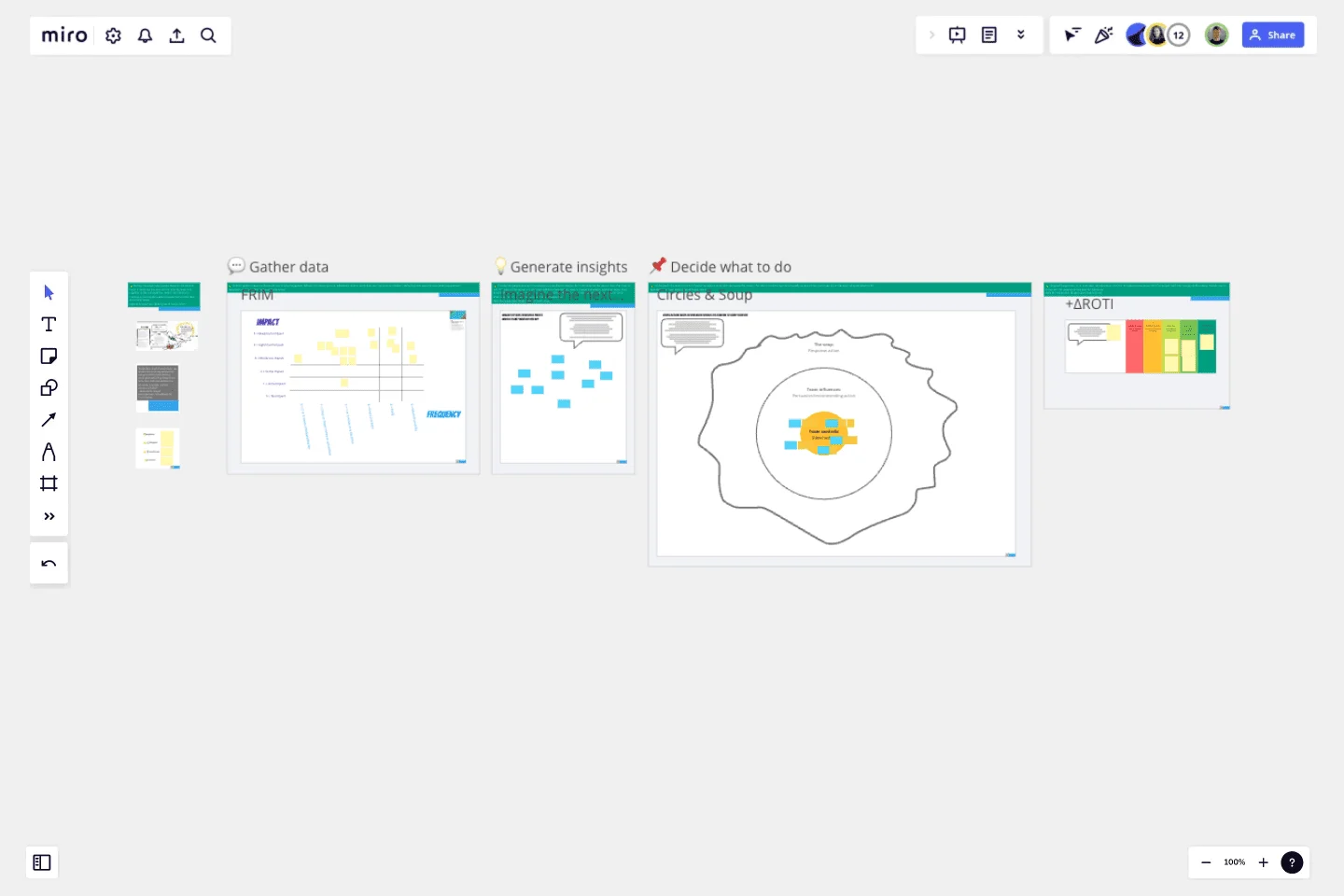Agile Retrospective
Gather and organize ideas with this retro!
This template offers scaffolding frames for the 5 steps of an Agile Retrospective to follow a structure that helps focusing the group on the work at hand, getting a shared perspective, fostering divergent thinking, coming up with actionable ideas and closing with a sense of having achieved something.
When to use this template?
You should try it if you your “retrospectives” are feeling ineffective and you have a feeling nothing ever changes, other challenges it helps with:
When you have room full of disengaged individuals
When your actions land on premature convergence and habitual thinking
Or there are no actions at all
Each frame has a set of activities that would fit a team of 5 or 6 looking at a 10/15 days time span. You should change activities if you think they don’t fit in your context.
How does a five steps Agile Retrospective work?
As a tech lead, scrum master or product manager you are challenged with running effective retrospectives. This template will guide you to focus on:
Setting the stage to be present and energized in a blame free mindset.
Clarify roles. Could it be useful to have somebody taking notes while you focus on facilitation? How about a timekeeper?
Is there any team agreement we need to highlight. The OARRs is the place!
You can then read Kerth’s prime directive from the template. Then you can do a voting on the ESVP (Explorer, Shopper, Vacationer, Prisoner). If everybody is a prisoner would it be beneficial to focus on why that is rather than going ahead with your plan?
Gather data to pause and collect all perspectives about the topic. The FRIM activity in the template uses axis with Frequency and Impact for the events we share.
Generate insights, divergent thinking about how the next iteration can be the best one yet?
Decide what to do to browse the ideas that emerged during generate insights and decide which ones we want to tackle in the next iteration. The template activity circles and soups allows to visualize what the team can control and the rest.
Close out to get feedback on the retrospective. In the template use ROTIPlusDelta to determine how the retrospective went and collect one change that would have increased your return on time invested and one thing you liked about the session.
If you’re used to the 3 column approach I wrote a blog post discussing pro and challenges of moving away from that.
The Agile Retrospective template is a Miro representation of an Agile Retrospective as intended by its creators in the seminal book “Agile Retrospectives Making good teams great” by Esther Derby and Diana Larsen. All activities are credited in the template itself.
Get started with this template right now.
The 4-Step Retrospective
Works best for:
Retrospectives, Agile Methodology, Meetings
The 4-Step Retrospective template offers a simple yet effective framework for conducting retrospectives. It provides steps for reflecting on what went well, what didn't go well, what could be improved, and action planning. This template enables teams to systematically review past iterations, identify areas for growth, and implement actionable improvements. By promoting a structured approach to reflection and improvement, the 4-Step Retrospective empowers teams to drive continuous learning and enhancement effectively.
RAID Log Template
Works best for:
Agile Methodology, Project Management, Agile Workflows
Use the RAID Log template to better understand potential risks, assumptions, issues, and dependencies relating to an upcoming project. With this information, you can make effective contingency plans and prepare your resources accordingly. You’ll know what could go wrong throughout the project and how to fix the problem.
Lean Inception Workshop
Works best for:
Agile, Lean Methodology
The Lean Inception Workshop streamlines project kickoff by aligning teams on goals, scope, and priorities. It leverages Lean principles to eliminate waste and maximize value, guiding exercises to define user personas, map user journeys, and prioritize features. By fostering cross-functional collaboration and customer-centric thinking, this template accelerates project initiation and ensures alignment between stakeholders, empowering teams to deliver customer value faster.
Start, Stop, Continue Template
Works best for:
Retrospectives, Meetings, Workshops
Giving and receiving feedback can be challenging and intimidating. It’s hard to look back over a quarter or even a week and parse a set of decisions into “positive” and “negative.” The Start Stop Continue framework was created to make it easier to reflect on your team’s recent experiences. The Start Stop Continue template encourages teams to look at specific actions they should start doing, stop doing, and continue doing. Together, collaborators agree on the most important steps to be more productive and successful.
What's on Your Radar Template
Works best for:
Business Management, Operations, Strategic Planning
Do you or your team feel overburdened by tasks? Having trouble focusing on particular problems? What’s on Your Radar is a thought exercise in which you plot ideas according to their importance or relevance. Designers and teams use what’s on your radar to ensure that their ideas are within the scope of a given project. They also rely on the method to assess whether a given solution is likely to solve the problem at hand. But even if you’re not a designer, the method can help assign priorities and ground your ideas in reality.
Lean Coffee Template
Works best for:
Agile Methodology, Product Management, Meetings
What makes a great meeting (other than donuts)? It’s appreciating everyone’s skills, resources, and time by making the very best use of them. That’s what the Lean Coffee approach is designed to do. Great for team brainstorms and retrospectives, Lean Coffee breaks the meeting into three basic stages: what to discuss, what’s being discussed, and what’s been discussed. This template makes it easy for you to collect sticky notes and to update the columns as you go from topic to topic.

